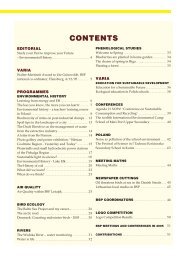newsletter_2008_1.pdf - 5.84 MB - The Baltic Sea Project
newsletter_2008_1.pdf - 5.84 MB - The Baltic Sea Project
newsletter_2008_1.pdf - 5.84 MB - The Baltic Sea Project
Create successful ePaper yourself
Turn your PDF publications into a flip-book with our unique Google optimized e-Paper software.
<strong>The</strong>se islands are located in the White <strong>Sea</strong>, near<br />
the Arctic Circle.<br />
<strong>The</strong>ir general area is 347 square kilometers. Among a great<br />
number of small islands, there are six major islands: three<br />
larger islands: Big Solovetskii (9246.9 km2), Anzer (24 km2),<br />
and Big Muksalma (17.6 km2) and three smaller islands:<br />
Small Muksalma and Big and Small Zayatskie. Along the<br />
major islands there are chains and groups of small islands<br />
covered by forests and bushes and also small stony islands<br />
called lud and heaps of stones called korg jutting out of the<br />
water.<br />
In 1998 the historical and architectural complex of these<br />
islands was nominated for the UNESCO World Heritage List<br />
of cultural monuments.<br />
It is really one of the most unique historical, architectural<br />
and religious complexes in Russia.<br />
One of the most esteemed Orthodox monasteries in<br />
Russia is located on the main island. <strong>The</strong>re are also about<br />
20 churches and other monastic objects and places of pilgrimage,<br />
including a church constructed with the help of<br />
Peter I on the islands. In the 19th century, one of these<br />
churches was equipped as a beacon and has been and is<br />
a unique historical and technical object that still operates.<br />
Monks also constructed a lot of objects that have technical<br />
and historical value: dams, systems of channels connecting<br />
lakes, water supply systems, an artificial pool with sea<br />
water for breeding fish, and unique labyrinths constructed<br />
in the 16–18 centuries.<br />
<strong>The</strong> purpose of these mysterious labyrinths remains<br />
unknown. <strong>The</strong>y labyrinths have been dated at different<br />
periods, including the 3rd century of our era.<br />
In the following year, UNESCO monitoring will be held on<br />
the islands. A group of students and teachers has decided<br />
to prepare material to change the nomination of this object;<br />
it can be nominated as a historical and natural object.<br />
<strong>The</strong> islands really represent a unique natural and landscape<br />
complex.<br />
On the limited territory, plenty of types of landscapes are<br />
combined: tundra (the most southern border of distribution<br />
of its biome), a coniferous taiga, mixed woods, meadows,<br />
various types of coasts, bogs (riding, local and aapa),<br />
and lakes<br />
<strong>The</strong> ornithological fauna of the islands is also very interesting<br />
and includes loons, eiders, ravens, various kinds of sea<br />
gulls, grey cranes (on the Russian list of endangered species),<br />
sea eagles (also on the Russian endangered species<br />
list), and fish hawks.<br />
Unique flora include six kinds of orchids, oaks (an oak of a<br />
very interesting form — clustering oak), dancing birches,<br />
and sundews.<br />
Beluga Cape<br />
EvENTS<br />
Photos: Stanislav Babitch<br />
<strong>The</strong> Solovetskie Islands<br />
When talking about the details of an expedition, we may<br />
say that the most fascinating and hard was our journey<br />
to Beluga Cape. What kind of animals are white whales or<br />
belugas in nature, what do they look like, and is it true that<br />
15





